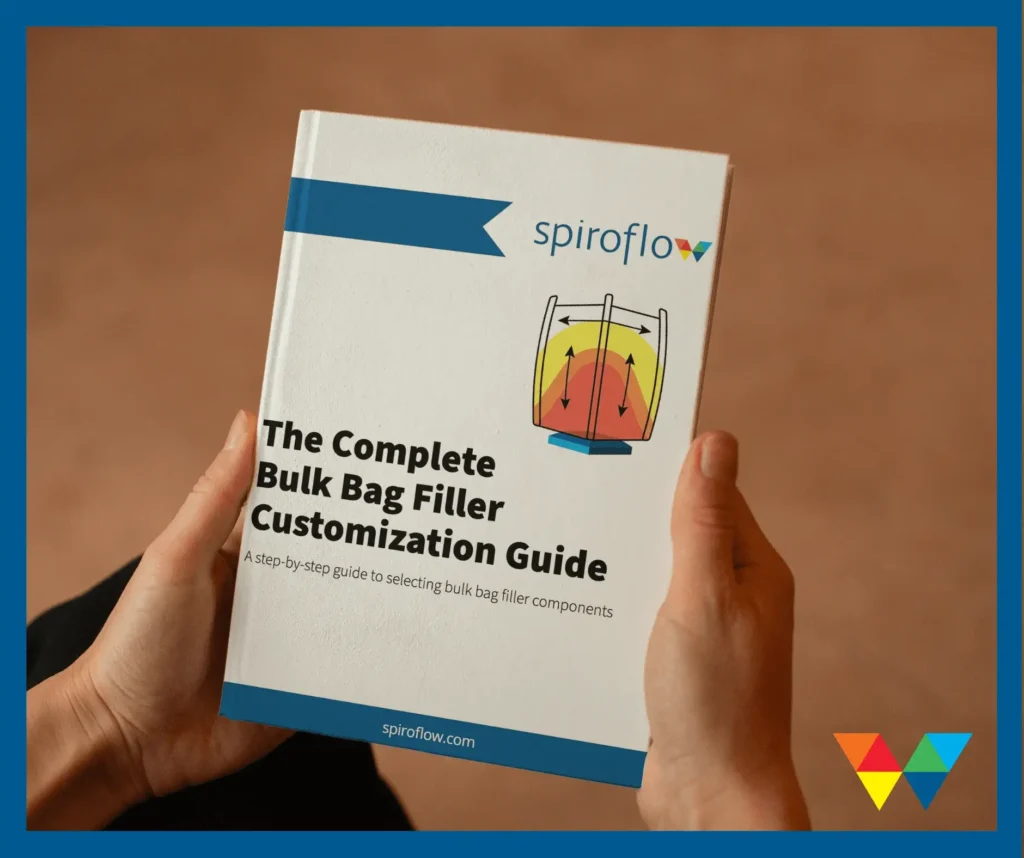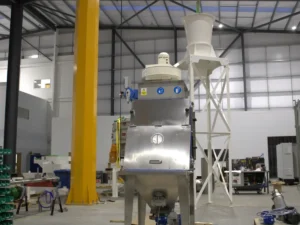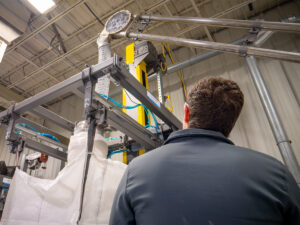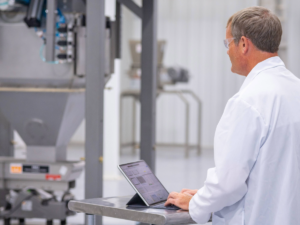Are you considering upgrading or expanding your bulk bag-filling line? Not all FIBC (Flexible Intermediate Bulk Container) bag fillers are the same. To assist you in choosing the right equipment, the team at Spiroflow prepared a thorough bulk bag filler customization guide to tailor your solution for the best results. Explore the world of bulk bag-filling customization and make informed choices with confidence.
Bulk bag filler customization involves tailoring bulk bag filling equipment to your specific needs and requirements. It includes the selection of components, features, and configurations to optimize the filling process. Customization ensures that your bulk bag filler is efficient, accurate, and perfectly suited for your materials and applications, reducing waste and increasing productivity.
Step 1: Narrow Selection: Bulk Bag Filler Frame Or Station
First, narrow the equipment selection to one of the following: a simple, stand-alone bulk bag filler frame or a more sophisticated filling system. To get the bigger picture, make sure you check out the options below:
Low Cost, Volumetric Filling for Simplified Operation
Bulk bag-filling frames are most suitable for low-rate applications, typically involving ten or fewer bulk bags per hour. This cost-effective choice is practical when weighing and densification aren’t necessary. However, it’s important to consider this option only if you have an operator consistently monitoring the filling progress and your material readily deaerates, making volumetric filling acceptable.
These frames typically feature a base plate with two vertical legs, allowing for vertical adjustment of the horizontal loop support arms. The filling nozzle support frame is positioned above the two loop arms, while locking pins ensure the secure positioning of the two sliding sections.
To remove filled bags, you deflate the inflatable collar, manually pull the neck from the filling spout, and then lift the pallet and the bag a few inches using a forklift or pallet jack. Finally, you can back the bag out of the filler.
C Series – Medium to High Volume Filling Minimizes Product Loss
C Series are bulk bag filling stations that cater to medium to high-volume applications where precise weight measurements or increased productivity are essential. They accommodate both forklift and semi-automatic bag removal via a motorized belt conveyor system. Unlike basic frames, complete filling stations often feature load cell weighing systems (either hang weighing or base mounted) and can incorporate vibration capabilities for efficient product densification, reducing overfill and minimizing product loss.
These stations comprise a support frame, bag support arms, fill head, dust extraction, weighing (load cells or platform scale), vibration table, and, in semi-automatic setups, a bag removal system. Additionally, customization options abound, allowing you to tailor your bulk bag filling station to specific application requirements, including automated conveyor systems for pallet feeding, shrink wrapping, or bag labeling.
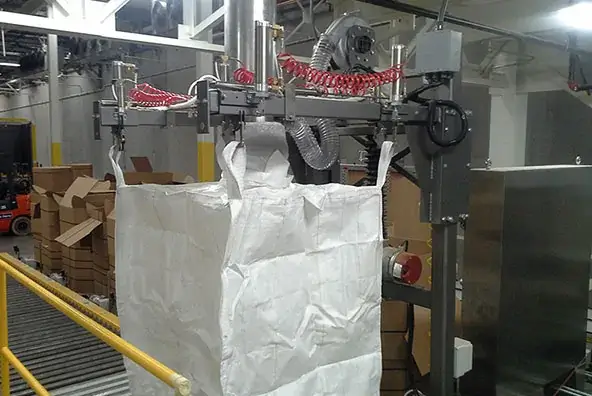
Step 2: Define Bulk Bag Filling Requirements
Before starting to specify the filler type, options, and customizations, first consider the material, process needs, bag requirements, and any seamless conveyor technologies to ensure a streamlined and efficient filling process.
Master Material Handling: Customization for Varied Material Characteristics
Choosing the right material-handling equipment is essential to ensure the success of your operation. Each material has unique characteristics, and customization is key to meeting specific requirements and challenges.
- Bulk Density
To gauge the need for material densification during bulk bag filling, consider the disparity between tamped and untapped bulk density. A difference of 10% or more signals the requirement for maximum densification to ensure a secure and stable bulk bag. The product’s filled bag should closely match its tamped bulk density for optimal results.
- Flow Characteristics
Material behavior during conveyance or filling dictates the ideal feed system (e.g., gravity, vibratory, metered) and the need for additional flow aids to maintain consistent material flow into the bag. This consistency is vital for accurate weighing from one bag to another. Even materials with minimal differences between tamped and untamped bulk densities, such as highly cohesive products, might necessitate densification. Likewise, easily fluidized materials, like some silica and titanium dioxide types, may require maximum densification.
- Temperature
Both the process material temperature and ambient facility temperature significantly impact bulk powder behavior during processing and the final filled bag condition. Elevated material temperature can alter material properties, with hot materials often exhibiting larger differences between tamped and un-tamped bulk densities compared to when they’re cooler.
This may necessitate maximum densification for achieving the target bag weight. Consider these temperature variations when evaluating a bulk bag filling station, especially when belt conveyor manufacturers perform pre-purchase testing
- Fragile/Friable
Fragile or friable products can be easily degraded during bulk bag filling without equipment customization. To prevent degradation, the bottom of the bag can be raised up to the filling head to reduce the drop height and then be gradually lowered as the bag fills.
- Perishable
Perishable dry bulk products, like food and ingredients such as nuts, may need a filling solution to extend their shelf life. Typically, bulk bags are inflated with air before filling. Yet, trapped oxygen in the bag can accelerate product degradation, especially for perishable goods. Nitrogen purging, replacing oxygen with nitrogen, helps extend the product’s lifespan during transport and storage.
Choose the Perfect Option With Bag Type Customization
Selecting the right bag type is another critical aspect of bulk bag filling customization. The choice of bag dimensions, style, lifting loops, and liner/sealing requirements can impact efficiency and safety.
- Dimensions
Bag height and volume requirements are typically the first considerations when selecting a bag type. Bulk bags are specified using their empty dimensions, which can vary greatly. Typically, base seam dimensions are no larger than 41″ to ensure that filled bags can be loaded two across in a typical trailer or shipping container. Bag heights can be as tall as 90″+ for very low bulk-density materials. When selecting bag dimensions, the final amount of product needed in the bag, pallet size, and method of shipping must be evaluated and considered.
- Style and Shape
Consult both bag and equipment manufacturers to determine the optimal bag style for safe storage and transportation. Filled FIBCs tend to round out, with circular woven bags showing the most rounding. U-panel or four-panel bags exhibit less rounding. Bags with internal baffles at the four corners round out the least and are ideal for sea container shipments to maximize shipping weight. The degree of rounding should align with the trailer/container width, dictating the bag construction method.
- Lifting Loops
There are two main FIBC lifting loop styles: lay flat and cross corner. Lay flat loops are used in U-style and 4-panel bags, sewn into vertical seams for vertical force distribution. Cross-corner loops are common in circular woven bags, eliminating vertical seams. They can also be used with other bag styles when lifting with forklift tines. These loops can feature inserts to further aid forklift insertion.
- Liner or Sealing Requirements
Bulk bag liners prevent foreign materials, moisture ingress, and fine powder egress. They’re crucial for various applications, including those involving edible materials, milk powders, or electrostatic discharge hazards. Liner types include form-fit, which mimics the bag’s shape and can be loose, glued, or stitched, and loose tubular, requiring inflation to match the bag’s shape during filling.
Process Customization for Precision and Efficiency
Customization is integral to fine-tuning the bulk bag-filling process to your specific needs. This involves assessing various factors, such as bagging rate, weighing accuracy, duty cycles, and space/storage requirements.
- Rate
Consider bagging rate, target weight, and densification requirements when selecting a bulk bag-filling system. For high bagging rates, explore options like automatic loop release, retractable loop hooks, and automatic bag removal. Bagging rates exceeding 20 bags/hr may require pre-weighing material in a hopper above the filler, significantly boosting the bagging rate to fill over 40 bulk bags per hour with a single filler.
- Weighing Accuracy
Weighing accuracy is vital to avoid overfilling and potential penalties for underweight bags. Accuracy, typically within +/- 2 lb (1 kg), is achievable with most systems. It depends on the metering device’s suitability for the application. For high bagging rates, consider specialized metering devices, such as a fast-acting gate valve or a surge hopper.
- Duty Cycle or Shifts
Consider how often your bulk bag-filling equipment will need to be on and running to meet productivity requirements. For extremely demanding applications and operating environments, filling systems should be designed to ensure extended duty cycles can be met without damaging equipment or introducing safety risks to operators.
- Space or Storage
Properly filled bulk bags are more stable and safer to stack two high. Stacking saves space and storage costs. Specialized bulk bag systems can even stack bags two high in the filler. This reduces the amount of forklift handling and time required to construct a two-high stack. Safety note: bulk bags should never be stacked without the input of the bulk bag and the bulk bag equipment manufacturers. Maximum densification is required when stacking any bulk bag. Testing before system implementation is critical to ensure safe operation.
Step 3: Select Bulk Bag Filling Station Components
Based on your requirements definition, start to select each component of your bulk bag filling station. Selection of individual components that make up your bulk bag filling station. These components collectively determine how efficiently and accurately your system operates.
Support Frame Builds the Foundation
The support frame is the backbone of any bulk bag filling station, providing stability and structure to the entire system. It’s a critical component that influences accessibility, safety, and overall functionality. Customizing the support frame allows you to tailor your bulk bag filling station to your specific requirements, ensuring that it efficiently and securely handles your materials.
- Post, C Frame Design
Two vertical tubes attached to a steel base frame provide a stable structure and easy access to three sides of the machine. Horizontal loop support arms can be vertically adjusted. A frame mounted above the two loop arms supports the filling nozzle. When filling by weight, the lower steel frame can be mounted on four load cells or a platform scale.
- Single Post, C Frame Design
A single steel post main support structure can provide unmatched access to bag spout and hanging loops. The bag hanger arms and fill head assembly are attached to the mast and can incorporate a base-mounted scale or hang weigh system.
- Low Loading
For limited headroom facilities, a low-loading bulk bag filler is essential. It reduces the filler’s height and enables easy bag removal with a pallet jack.
- Automatic Loop Release
For semi-automatic bags, it’s best to use removal roller conveyor belt systems and move the filled bag from the bulk bag filler. When the target weight has been reached, the bag hooks simultaneously open to release the bag loops from the filler.
- Hang Filling
The bulk bag is suspended in the air via its loops during filling and is periodically lowered onto a vibrating cone table for densification. Hang filling and cone table densification result in more stable bulk bags and typically increase the amount of weight that can be filled into a given size bag or allow the use of a smaller bag to contain the target weight.
- Bottom Support – Flat Plate
The bulk bag sits directly on the pallet, which rests on the flat base plate attached to the frame of the bulk bag filler.
- Bottom Support – Roller Conveyor Belts
The bulk bag sits on the pallet, which rests on the rollers of roller conveyor solutions that are attached to the base frame of the filler. This allows filled bags to be semi-automatically removed from the filler.
Filling Nozzle or Fillhead Enhances Precision and Efficiency
The filling nozzle or fillhead is another essential component in the bulk bag filling process. It not only facilitates the controlled flow of material but also contributes to the efficiency and precision of your operation. Here are all the options you need to be aware of:
- Tilting Fillhead
It’s ideal for improved ergonomics. A tilting full head tilts the fill head towards the operator, reducing the reach required to pull the bulk bag inlet spout over the fill head.
- Twin Tube/Dust Extraction
To maintain dust containment while filling, displaced air is extracted from the bulk bag using a dust collection system. This is achieved through a dust vent located in the outer tube of the fill head.
- Filling Head Spinner
To ensure even product dispersion during filling, a spinner head can be employed to distribute the product into the baffle, ensuring that the bag’s corners are adequately filled. This option is particularly useful in cases where the material’s angle of repose hinders complete filling in the top corners when simple vibration isn’t sufficient.
- Bag Liner Inflation System
To achieve perfectly filled bags, a fan or compressed air venturi is used to inflate the bag with air (or nitrogen) before filling, eliminating fabric creases and ensuring maximum capacity is reached.
Weighing or Scale Type Options
In a base-weigh system, both the entire bulk bag filler and the product in the bag are weighed throughout the filling process. Conversely, hang-weigh systems weigh only the weight frame, fill head, hanger arms, and the bulk bag itself during filling when it’s suspended from its loops. This hang-weigh arrangement minimizes the dead load on the load cells, enhancing weighing resolution for improved accuracy and consistency.
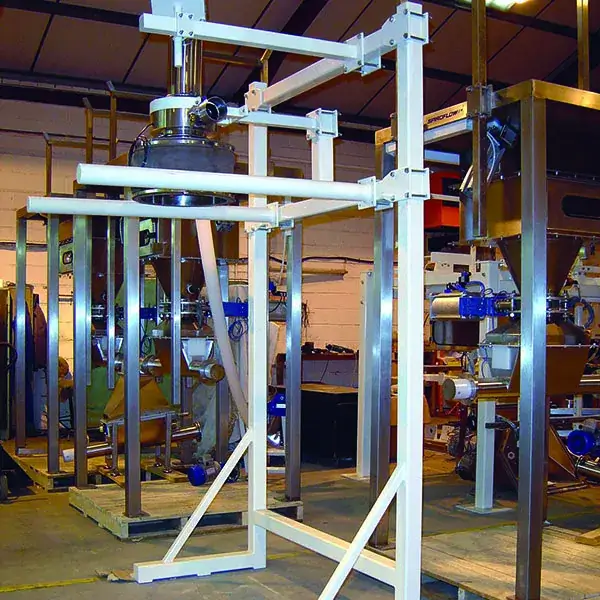
Vibration Compaction and Deaeration
Achieving a homogeneous fill while removing trapped air and promoting material flow are essential steps in bulk bag filling. Vibration compaction, deaeration, and a top-notch flexible screw conveyor play a crucial role in optimizing these processes.
- Cone Table – CTE
Vibration energy is injected directly into the material in the bag by periodically lowering the bag onto a vibrating cone table. The CTE method provides maximum densification, which is particularly useful when filling difficult-to-deaerate materials. This is because cone table densification densifies any material more quickly than through-pallet fillers when the bag filling rate must be maximized.
- Through Pallet – C1-2
In this method, vibration energy is effectively transmitted through the pallet and directly into the bulk bag. This technique involves mounting the vibration equipment on the pallet itself, allowing for a more direct and forceful transfer of energy.
- Finger Style – C2-2
Vibrating bars or fingers are raised through the in-filler conveyor belt system to allow for thorough pallet densification of bags sitting on a pallet.
Step 4: Customize Bulk Bag Filling Station With Additional Options
In this step, we delve into the realm of customization, where the versatility of bulk bag-filling stations truly shines. Beyond the fundamental components, a world of additional options awaits, designed to tailor your equipment to your unique operational needs. Whether it’s enhancing safety and productivity or even extending the shelf life of your products, these supplementary features can make a world of difference. This being said, here are some of the options conveyor systems manufacturers recommend to keep in mind:
Explosion Proof (Static Monitoring/Grounding)
This step is a must for explosion risk applications. If the area poses an explosion risk, static dissipative or groundable bags may be needed together with a suitable static monitoring system.
Mobile Options
Consider possible mobile options if you need to move your filler to different fill locations. Wheeled mobile base units are available, utilizing two rigid casters. Two swivel lockable caster and pneumatic cylinders can also be used to isolate the load cells during movement.
Control Systems Integration
Efficient and precise control of your bulk bag filling station is integral to achieving optimal results. Here are some steps you can take to streamline your operations and maximize efficiency:
- Automatic gain-in-weight filler – The bag is weighed as it is filled until it reaches the target weight. The system can be programmed to automatically fill the bag to the target while densifying the bag according to a pre-programmed sequence.
- Weight display – For manual filling to a target weight. The operator initiates filling and monitors the weight display. When the display approaches the target weight, the operator manually stops the filling process.
- Pre-weigh – For achieving maximum fill rates while maintaining accuracy. Material is measured and weighed in a dedicated hopper before being quickly transferred to the bag.
Nitrogen Purging
The bulk bag is filled with nitrogen, purging the bag of oxygen before and during filling to extend the storage life of perishable materials. Bacteria feed on oxygen, so by removing it, products will last longer during storage and transportation.
Heat Sealing
If you need your storage life of perishable materials to be extended, this is the right option for you. Combined with nitrogen purging, heat-sealing can significantly extend stored product life.
Automatic Height Adjustment
An option that allows the operator to quickly adjust the height between filling cycles to accommodate different bag sizes.
Hygienic Requirements
Stainless steel product contact surfaces, food-grade finishes, and bag inflation with HEPA filters may be required to meet Good Manufacturing Practices in the food and beverage industry.
Access Platforms
The bulk bag filler design, bag height, and the integration of roller conveyors to automatically remove filled bags may require the operator to be elevated above floor level to allow rigging of the bulk bag.
Step 5: Test, Test, and Once Again Test
Before purchasing bulk bag filling equipment, it is recommended to first run the material on the equipment in the bulk bag equipment manufacturer’s test lab. Replicating the filling conditions allows analysis of specific characteristics, including how the material interfaces with industrial conveyor systems, to avoid production challenges later.
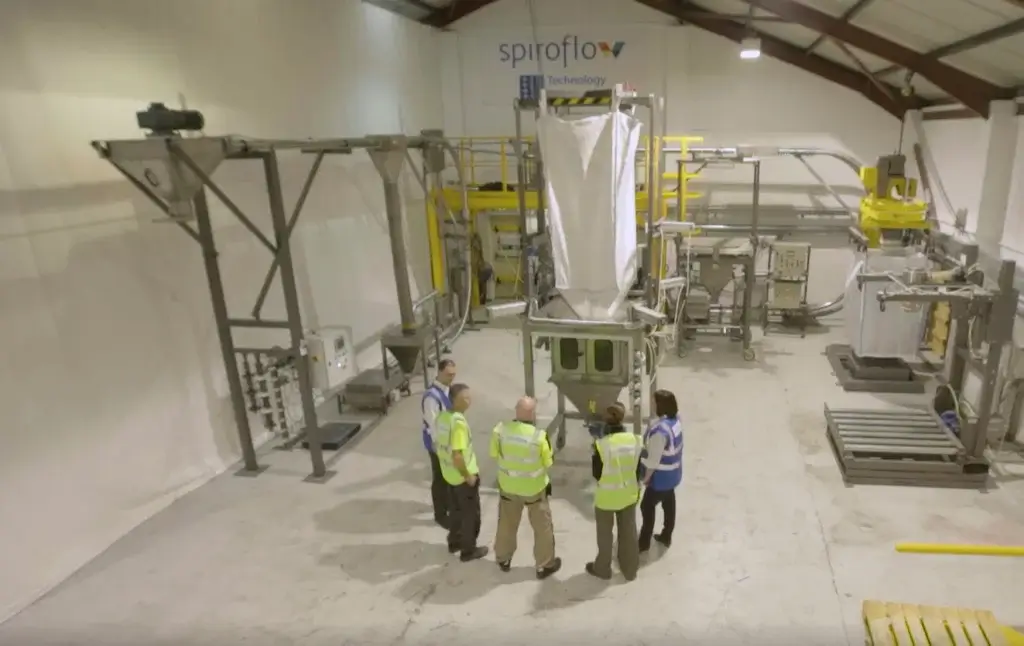
Use Spiroflow’s Bulk Bag Filler Customization Guide for Seamless Operation
Achieving a seamless and efficient filling process isn’t as easy as you might have thought. But don’t worry – with our comprehensive guide and top-notch conveyor belt solutions, your operation will be more than successful. By tailoring your equipment to your unique needs and considering every element, from material characteristics to bag types, you can optimize safety, productivity, and product quality. Don’t miss out on the opportunity to elevate your bulk bag-filling process, and contact Spiroflow today!

